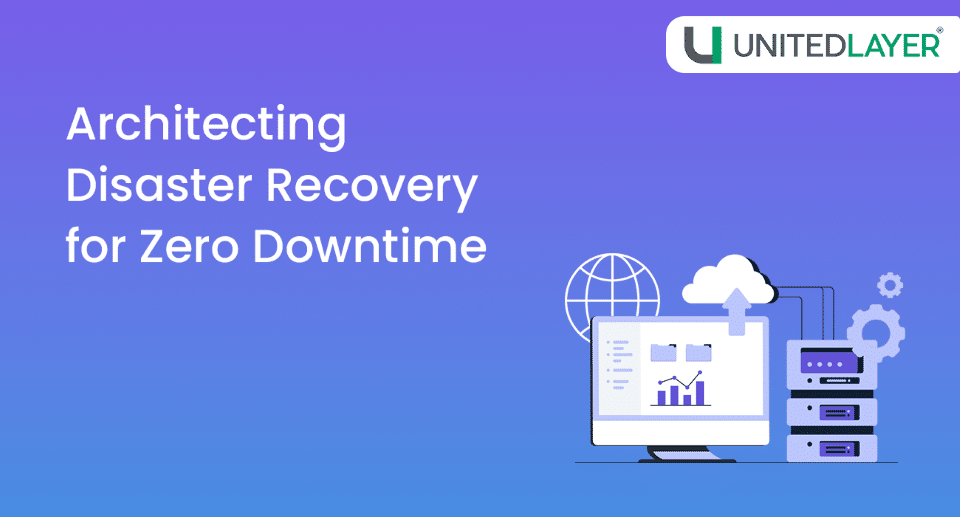
A disaster, whether caused by natural occurrences such as floods or earthquakes, technical failures like power or network outages, or human factors including inadvertent errors or unauthorized changes, can restrict the workload from performing its intended functionality in its primary location. Such disruptions result in downtime, data loss, and sometimes financial or reputational repercussions.
Recognizing that seamless business continuity in the face of unexpected adversities can be a formidable challenge for enterprises, this blog post explains how to architect robust disaster recovery (DR).
With 30+ private cloud regions and 175+ edge locations across five continents, UnitedLayer enables enterprises to implement multi-AZ and multi-region disaster recovery strategies. This distributed footprint provides data sovereignty, low latency, and regulatory compliance while allowing rapid failover to unaffected locations.
Multi-AZ Disaster Recovery
A Multi-Availability Zone (multi-AZ) architecture designed to minimize risks of downtime. Each Availability Zone comprises one or more Tier 3+ data centers located in geographically separate areas. This segmentation lowers the chance that a single disaster event, such as a power outage, flood, or other localized disruption, impacts multiple Availability Zones simultaneously.
Multi-Region Disaster Recovery
A multi-region architecture replicates critical workloads and data across multiple regions. This design enhances resilience by protecting against large-scale disasters affecting multiple data centers or entire Availability Zones in one region. It enables rapid failover to backup regions, minimizing downtime and data loss during catastrophic events.
United Private Cloud® provides four disaster recovery strategies that have varying RTO and RPO objectives. To choose the most suitable strategy, you must determine the RTO and RPO based on your workload, as well as the investment in money, time, and effort you are willing to make.
Active/Active
It involves deploying workloads simultaneously across two or more Regions, all of which actively process and accept requests. In the event of a failure, failover is achieved by rerouting requests away from the affected region. Data is continuously replicated and synchronized across regions to support both read and write operations with near-zero latency replication, resulting in extremely low Recovery Point Objectives (RPO) — often within seconds. Additionally, data backups are maintained to enable restoration in cases of accidental deletion or corruption.
Active/Passive
In an Active/Passive DR setup, the primary site (active) runs the workload and handles all production traffic, while the secondary site (passive) maintains live data replication and periodic backups but runs with minimal infrastructure and reduced capacity. The passive site is not actively serving production workloads under normal circumstances—it is kept ready to scale up and take over when failover occurs.
Active/Passive approach maintains a warm standby that can be rapidly activated but is not hot at all times.
Active/Replicated
It involves continuous or periodic data replication to a secondary standby site that is not actively processing workloads. Unlike Active/Passive setups, this passive site has minimal infrastructure and requires provisioning to handle production traffic during failover. This cost-effective approach suits non-mission-critical or archival workloads where longer RTO/RPO are acceptable.
Backup & Restore
Backups are created within the same Region as their source data and are also replicated to another Region, protecting against disasters of varying scope. It is essential to not only recover data from backups but also to restore the infrastructure. Using Infrastructure as Code (IaC) tools—such as CloudFormation or Terraform—allows for consistent, repeatable deployment of infrastructure components across regions, which reduces manual errors and accelerates recovery. However, the backup and recovery strategy is considered the least efficient option for RTO.
Disaster recovery (DR) planning revolves around two metrics: Recovery Time Objective (RTO) and Recovery Point Objective (RPO). These objectives help organizations define acceptable thresholds for downtime and data loss in the event of a disruption.
For RTO and RPO, lower values indicate reduced downtime and data loss. Leveraging UnitedLayer®’s comprehensive multi-AZ and multi-region disaster recovery strategies—with 30+ private cloud regions, 175+ edge locations—and DR strategies such as Active/Active, Active/Passive, Active/Replicated, and Backup & Restore, enable enterprises to easily achieve defined recovery objectives. However, lower RTO and RPO typically incur higher costs due to increased resource allocation and operational complexity. It is thus essential to validate RTO and RPO objectives with business requirements.
While disaster Recovery (DR) is a vital component of business continuity planning, as is the high availability of workload for overall resilience. United Private Cloud®, therefore ensures 99.999% workload availability through N+M cluster architecture, maximizing the operational uptime of your applications and enabling workloads to consistently perform their intended business functions.
Customize your Disaster Recovery Strategy with UnitedLayer. Define the most appropriate disaster recovery strategy per business requirement and leverage UnitedLayer to architect the DR solution tailored to your RTO/RPO, supported by a comprehensive consultancy framework that enables preparation, including bi-annual and on-demand DR drills, to ensure audit readiness, compliance, and rapid recovery when a disaster occurs.